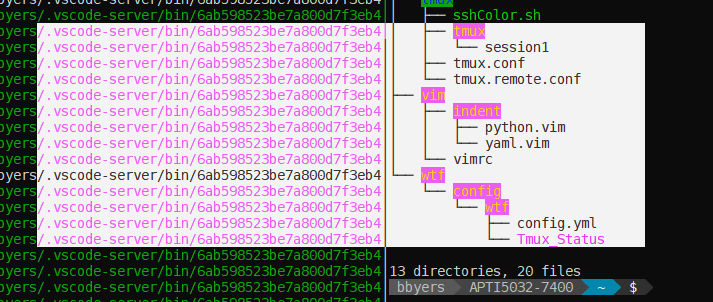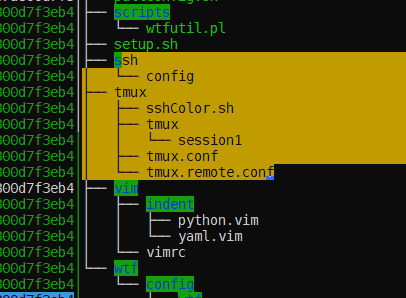My Tmux Setup
21 Oct 2019 | 4 minutes to readTmux is a “Terminal Multiplexer”, meaning you can create and use multiple terminals in one window at the same time. It can be extensively customized and there are tons of examples of configurations posted all over the place.
My configuration lives in my configuration github repo.
In the tmux folder, you’ll find two config files names tmux.conf and tmux.remote.conf.
The regular configuration is for the local computer, while the remote conf is for servers you remote into and start a tmux session on (usually through ssh).
The remote session has a few less lines, and a different prefix.
Copying and pasting with WSL
One issue I ran into with tmux was running it on WSL. It can be difficult to setup each so you can easily copy and paste within tmux and externally.
Set WSL to use Ctrl+Shift+C/V as Copy/Paste in the options tab of wSL settings.
To select text within the terminal to copy externally, hold
To select text to copy into windows, you’ll want to hold either shift or alt+shift.
Holding shift will select line by line of the WSL window.
I only use this mode when I have a single panel in view.
If there are multiple panels, it ignore the boundaries.
If you have multiple panels open, alt+shift will select a rectangle instead of line by line.
Once the text you want is selected, press enter to add it to your windows clipboard.
If you select text accidentally, press escape before trying to select again or else it will select from the original selection start to where you click.
To copy text to the tmux clipboard, you’ll simply select the text with the mouse without holding any keys down.
You can view the list of things you’ve copied by pressing prefix+=.
Then you can select which thing to insert at the cursor.
Commands
Quick list:
- Prefix is
alt+z prefix+R: Reload configurationprefix+r: Redraw windowshift+arrow: Switch windowsprefix+S: Open new window from session templatealt+arrow: Switch panesprefix+z: Zoom in current paneprefix+-: Horizontal split current paneprefix+|: Vertically split current paneprefix+=: Open tmux clipboard
These commands are all set in the .tmux.conf file present in my $HOME directory.
When making changes and customizing tmux, it is useful to be able to easily reload the configuration when you make changes.
To do this, I use the bind bind R source-file ~/.tmux.conf.
The first command I reset was the prefix key.
By default, it is set to alt+b, which is quite a stretch to reach.
I set my local tmux prefix to alt+z and the remote to alt+x.
This allows me to differentiate between the tmux session running locally or the tmux session nested within an ssh session on another server.
Additionally, alt+z is much easier and quicker to hit that the default.
The configuration code:
set -g prefix M-z
unbind C-b
bind M-z send-prefix
One command I use often is zoom.
prefix+z takes the current pane and full screens it.
It’s useful for when you want to take a closer look at some output that smooshes just the wrong way when sequestered in a pane.
Moving between panes and windows quickly is important.
The default configuration can be difficult to remember, and not intuitive.
To switch between panes, I use alt+arrow.
It’s also set so there is no need to push the alt+z prefix key to switch.
# Use alt+arrows to switch between panes
bind -n M-Left select-pane -L
bind -n M-Right select-pane -R
bind -n M-Up select-pane -U
bind -n M-Down select-pane -D
To switch between windows, I use shift+arrow.
# Use shift+lft/right to switch between windows
bind -n S-Left previous-window
bind -n S-Right next-window
To create additional panes, I modified the commands to use - and | to split horizontally and vertically.
Additionally, all pane creation is done with the right hand instead of different hands doing different splits.
bind | split-window -h
bind - split-window -v
Having pre-configured windows that have a custom setup can be useful.
Once you create the file configuring the session, you can place it in a directory and bind a host key to automatically open it.
In my case, I use bind S source-file ~/.tmux/session1, which opens a custom view in a new window.
Other settings:
set -g base-index 1: Starts window numbering from 1, because 0 is on the other side of the keyboard.set -g mouse on:This allows me to use the mouse to do things like resize windows, select text, and click between panels.set -sg escape-time 0: Stop having to wait to press esc twice when canceling things.set -g history-limit 10000: Scrolling remembers 10,000 lines.setw -g mode-keys vi: Set mode to vi instead of emacs.





